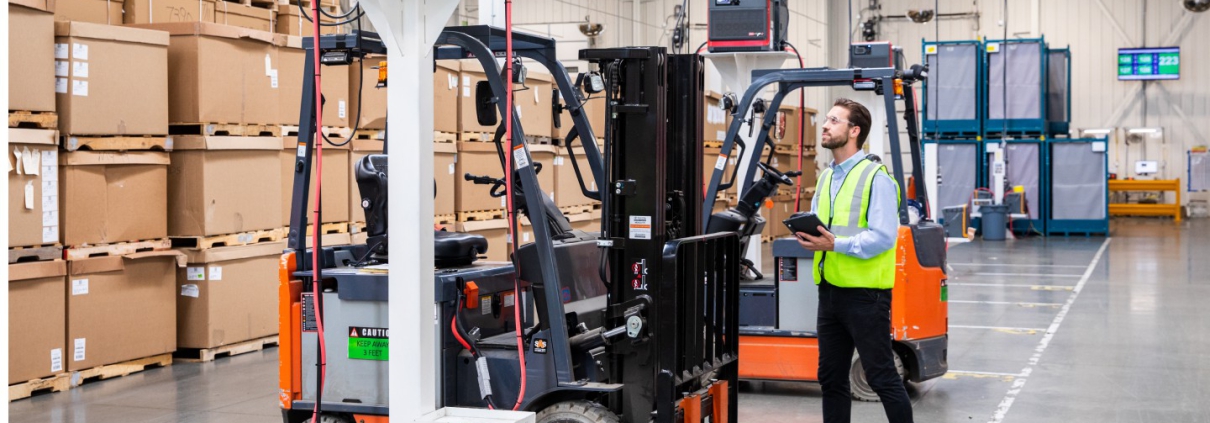Forklift Battery Maintenance: What Warehouse Managers and Operators Need to Know
Introduction: Why Battery Maintenance Isn’t Optional
Forklifts are the backbone of most warehouse and industrial operations—and the battery that powers them is just as critical. But many operations underestimate the importance of proper battery maintenance until problems start to pile up: shorter runtimes, unexpected shutdowns, rising replacement costs, and safety hazards.
Whether you’re using lead-acid or lithium forklift batteries, the right maintenance practices can extend battery life, improve performance, and keep your fleet running efficiently. This guide breaks down everything warehouse managers, technicians, and forklift operators need to know about maintaining their batteries—and when it might be time to rethink your strategy.
- The Fundamentals of Forklift Battery Maintenance
Daily Maintenance Tasks for Lead-Acid Batteries
Lead-acid forklift batteries require a strict maintenance regimen to operate safely and last their full lifespan. Your daily checklist should include:
- ✅ Check water levels: Ensure electrolyte levels are within the recommended range. Only top off with distilled water after charging.
- ✅ Inspect for corrosion: Clean terminals and connectors with a baking soda solution if corrosion is visible.
- ✅ Ensure proper ventilation: Charging produces hydrogen gas—proper ventilation is critical to prevent fire hazards.
- ✅ Visual damage check: Look for bulging cases, cracked housings, or acid leaks.
- ✅ Equalize charging (weekly): Perform an equalization charge weekly to balance cells and reduce sulfation.
Failing to perform these tasks can result in premature failure, lost capacity, and even workplace safety incidents.
Lithium Battery Maintenance: Lighter Workload, Smarter System
Lithium batteries are much lower maintenance by design. Most come with an integrated Battery Management System (BMS) that monitors state of charge, temperature, and fault conditions in real time.
Key advantages:
- ❌ No watering
- ❌ No acid spill risks
- ✅ Built-in protection from overcharging and overheating
- ✅ Real-time health tracking via BMS
With lithium, your team spends less time on manual checks and more time focusing on operations.
- Most Common Forklift Battery Maintenance Mistakes
Even experienced operators can unknowingly shorten battery lifespan through improper handling. Some of the most common maintenance mistakes include:
- 🔋 Opportunity charging lead-acid batteries: Topping off charge during breaks may seem efficient but damages lead-acid cells over time.
- 🌡️ Ignoring temperature conditions: Cold storage facilities can stress both battery types if not properly managed.
- 💧 Adding water before charging: This causes electrolyte overflow and dilution.
- ⛔ Skipping regular inspections: Especially critical for large fleets where unnoticed issues can escalate.
- Maintenance Schedule Template: Daily, Weekly, Monthly
| Task | Lead-Acid Battery | Lithium Battery |
| Visual inspection | Daily | Weekly |
| Electrolyte level check | Daily | N/A |
| Equalize charge | Weekly | N/A |
| Connector and terminal cleaning | Monthly | Quarterly |
| BMS performance review | N/A | Weekly |
| Battery temperature logging | Weekly | BMS controlled |
Downloadable versions of this maintenance checklist can be made available to staff for better record-keeping and accountability.
- How Maintenance Impacts Total Cost of Ownership (TCO)
Poor maintenance not only reduces battery lifespan but increases the total cost of ownership (TCO) through:
- ✅ More frequent replacements
- ✅ Higher electricity costs from inefficient charging
- ✅ Labor costs for emergency interventions
- ✅ Downtime losses from mid-shift failures
In comparison, lithium batteries—despite higher upfront cost—often deliver better ROI due to reduced maintenance demands and longer service life.
- Maintenance System Tips for Large Fleets
If you’re managing a large number of electric forklifts, a formalized maintenance system is essential. Recommendations include:
- 🗓️ Automated reminders for inspection and charging cycles
- 📋 Centralized logs of battery health and service history
- 📊 Fleet-level performance tracking using telematics or BMS integration
- 👨🏫 Operator training programs with certification checklists
Proper systems lead to more predictable replacement planning and better budgeting.
- Choosing the Right Battery for Your Maintenance Strategy
The battery chemistry you use will determine your long-term maintenance requirements. If your operation is growing or struggling with upkeep, it’s worth reassessing your battery choice.
Explore different forklift battery options to see how lithium, lead-acid, and other chemistries compare in terms of maintenance, cost, and performance.
📌 Tip: High-throughput environments (e.g. cold storage, 2–3 shifts per day) often benefit most from lithium batteries due to fast charging, minimal downtime, and no watering required.
- When It’s Time to Move On: Replacing Instead of Maintaining
Are your maintenance costs piling up? Is your team spending too much time watering and monitoring batteries instead of running operations?
If so, it may be time to consider a smarter upgrade. Learn more in our step-by-step guide on how to replace a lead-acid forklift battery with a lithium one. It covers key compatibility checks, safety tips, and installation advice for a smooth transition.
Conclusion: Maintenance Isn’t Optional—But It Doesn’t Have to Be Hard
Proper forklift battery maintenance is essential to uptime, safety, and long-term ROI. While lead-acid batteries demand daily attention, lithium solutions offer a streamlined alternative with lower labor requirements and fewer risks.
By understanding your battery’s needs—and being proactive about care or upgrades—you can ensure your forklifts stay charged, productive, and profitable.
🔗 Recommended Links:


